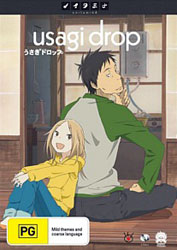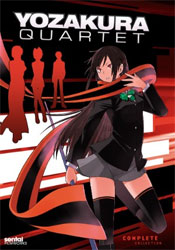 Publisher: Funimation (USA)
Publisher: Funimation (USA)Format: Region 1 DVD, NTSC, Japanese Dialogue with optional English dub and English Subtitles.
Length: 26 episodes x 24 minutes
Production Date: 2007
Currently in Print (as of writing): Yes
Ren Mihashi was the “ace” pitcher in his former school’s baseball club. Apparently the only reason why he was selected to be pitcher was the fact his grandfather owned the school. Coupled with his slow pitches which made every game for the school a lost one, the team aren’t exactly friendly with him. Mihashi decides to break away from what is a horrible situation by moving to a new prefecture and to a new high school, Nishiura High. However his self-esteem is at rock bottom due to his experiences at his former high school. Yet he still decides to join the baseball team. He almost decides not to re-join, but the rather quirky female coach, Maria Momoe, essentially forces him to join. In the team he befriends the catcher, Takaya Abe, and becomes the team’s main pitcher, despite the fact his pitches are rather slow. However Abe seems that there is more to Mihashi’s pitching style than meets the eye, and due to his directions Mihashi gains his utmost trust.
With the pitcher and catcher working in almost total harmony and the rest of the team in place, a practice match is set up. The group set off on training camp. Unfortunately the team playing them turns out to be from Mihashi's old school. Mihashi already has a rather skittish and shy personality, but with the prospect of facing his former taunters, he loses confidence big time. However Abe manages to build up his confidence enough so he can play. Things seem to be going well with Mihashi striking most of his former team mates out (thanks to Abe’s directions), however Abe now thinks that Mihashi is getting homesick for his old team, and has to shake the feelings out of him. With their first success, the team now prepares for the Summer National Senior High School Baseball Championship. Unfortunately the team they have picked to play is the team that won the championship last year. How can a bunch of rookies win against them?
With the pitcher and catcher working in almost total harmony and the rest of the team in place, a practice match is set up. The group set off on training camp. Unfortunately the team playing them turns out to be from Mihashi's old school. Mihashi already has a rather skittish and shy personality, but with the prospect of facing his former taunters, he loses confidence big time. However Abe manages to build up his confidence enough so he can play. Things seem to be going well with Mihashi striking most of his former team mates out (thanks to Abe’s directions), however Abe now thinks that Mihashi is getting homesick for his old team, and has to shake the feelings out of him. With their first success, the team now prepares for the Summer National Senior High School Baseball Championship. Unfortunately the team they have picked to play is the team that won the championship last year. How can a bunch of rookies win against them?
So this is the second sports anime and Funimation titles I’ve watched in as many weeks. Sports anime is not my favourite genre, however the way a lot of these shows are constructed (especially non-shonnen ones, such as this show - it’s from a seinen manga) make them quite intriguing. Unlike “Bamboo Blade”, this show is heavily focused on the sport side rather than the non-sport aspect of the character’s lives. The first few episodes did really turn me off. First problem was Ren Mihashi. I could generally accept his extreme shyness and barely tolerate his constant crying, but his actions in the early episodes made little sense. In particular going from situation where baseball was hell due to his team mates, then moving to a different prefecture and REJOINING the school’s baseball club. I mean, what the hell? It just doesn’t make any sense. The other aspect to this is he rejoins in the same position which made his life a misery; pitcher. The other problem I had with the show is how fast it went from the initial members joining to full on matches. There seemed to be no time from training or anything. And nobody seems to try out for the positions. People just stated what they were and nobody, not even the coach, said anything. And speaking of the coach, Maria Momoe, I don’t really see the point of making her exceptionally breasty.
Once the baseball starts, that’s when the show really kicks into gear. The fascinating part for me was the tactics used in the games, in particular those thought up by Abe and Momoe. I did play baseball in high school (for one tortuous term only), but there was hardly any coaching from the teacher, let alone any mention of using tactics during the game. I know baseball is pretty big in Japan, but it really seems to different to the US system of college sports where it resembles a slightly watered down professional set up. I don’t know, but wouldn’t it be more fun for the kids if there wasn’t all that pressure? Surely not many of them are gunning to make to the pro league? That aside, because of that the games are really nail biting at points. I was really thoroughly entertained during these parts, perhaps because I knew the basics of the game. At the very least I thought the show was realistic. The kids didn’t really show any silly superhuman skills which many sports anime fall back on. Some of Funimation’s terminology was rather odd at times. Some of it wasn’t familiar to me or I knew certain aspects of the game under different names (admittedly I’m not too well versed in baseball, I just know enough to get by). Luckily this only happened a couple of times. One of the problems with the show is that even though the team states that they want to go to Koshien (Hanshin Koshien Stadium where the finals are held), all we see are a practice match and the first official match, which are spread over almost the entire 26 episodes. The show also mostly focuses on Mihashi and Abe exclusively. The final episode (an OVA extra) focuses on a player in other team before the events of the first episode. It really feels out of whack because we only briefly follow the player in the series. I think more time should have been allotted to individual team members and series is way too short for the scope of the story. A second 13 episode series was broadcast in 2010, but I think this show need more time devoted to it than that. In the end it was pretty entertaining, but some aspects where a little hard to swallow, but most of these relate to the early episodes. I really think this show would have benefited greatly from a much longer episode count. 6.5 out of 10.
Remaining Backlog: 28 months (it's much easier this way than listing the number of discs).
Once the baseball starts, that’s when the show really kicks into gear. The fascinating part for me was the tactics used in the games, in particular those thought up by Abe and Momoe. I did play baseball in high school (for one tortuous term only), but there was hardly any coaching from the teacher, let alone any mention of using tactics during the game. I know baseball is pretty big in Japan, but it really seems to different to the US system of college sports where it resembles a slightly watered down professional set up. I don’t know, but wouldn’t it be more fun for the kids if there wasn’t all that pressure? Surely not many of them are gunning to make to the pro league? That aside, because of that the games are really nail biting at points. I was really thoroughly entertained during these parts, perhaps because I knew the basics of the game. At the very least I thought the show was realistic. The kids didn’t really show any silly superhuman skills which many sports anime fall back on. Some of Funimation’s terminology was rather odd at times. Some of it wasn’t familiar to me or I knew certain aspects of the game under different names (admittedly I’m not too well versed in baseball, I just know enough to get by). Luckily this only happened a couple of times. One of the problems with the show is that even though the team states that they want to go to Koshien (Hanshin Koshien Stadium where the finals are held), all we see are a practice match and the first official match, which are spread over almost the entire 26 episodes. The show also mostly focuses on Mihashi and Abe exclusively. The final episode (an OVA extra) focuses on a player in other team before the events of the first episode. It really feels out of whack because we only briefly follow the player in the series. I think more time should have been allotted to individual team members and series is way too short for the scope of the story. A second 13 episode series was broadcast in 2010, but I think this show need more time devoted to it than that. In the end it was pretty entertaining, but some aspects where a little hard to swallow, but most of these relate to the early episodes. I really think this show would have benefited greatly from a much longer episode count. 6.5 out of 10.
Remaining Backlog: 28 months (it's much easier this way than listing the number of discs).


















